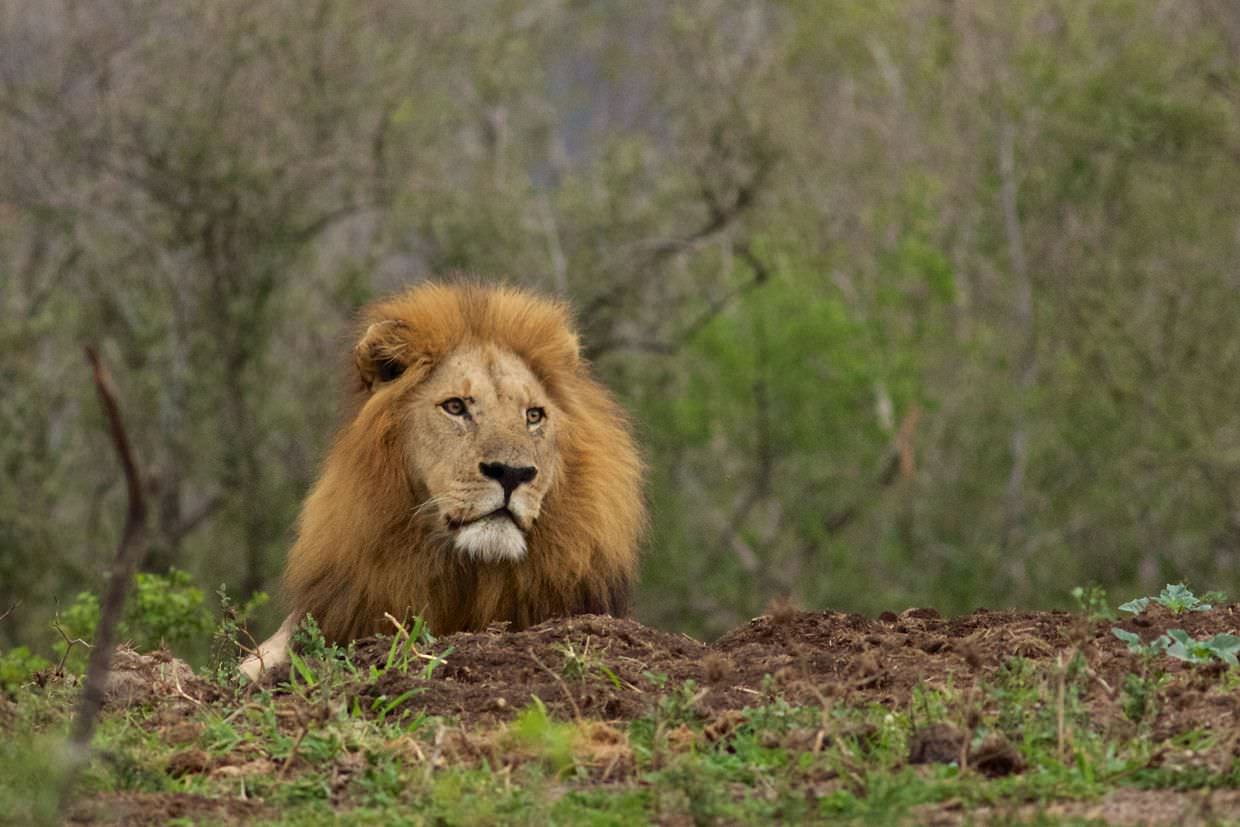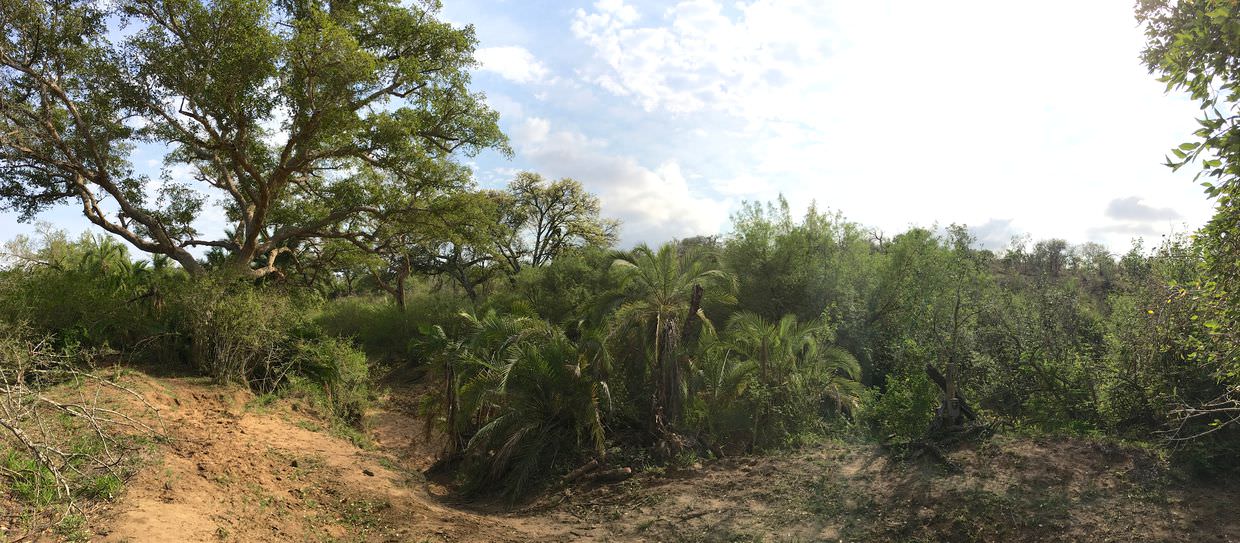A day trip to Hluhluwe and bumping lions
Day 10 – A day in Hluhluwe
Kelsey needed to drive to research up in Hluhluwe to drop off some photos, dog scat and other research material we’d gathered. We left again at 4:30am and headed north through the park, stopping to scan for Alfie’s pack again on the way.
This time we went straight to Nselweni but their signal had moved and you have to follow the signal. Out and around, we drove the 20 minute trip over the river, and up the hill. On the way we found a lone male lion, he didn’t seem comfortable, and when we stopped he limped away.

The signal told us they were over the distant hills; Kelsey called in on her radio and we got permission to follow them along a management track. The path was rocky, and with each divot, hole and bump, the truck swayed left and right, bashing us against the black railings and renewing our bruises. But the views were incredible. We could see right across the park, the peaks, valleys and trees looked beautiful against the early light. We passed sleeping buffalo, an old buffalo skull and some woolly necked storks.
This is where we had our favourite rhino sighting. Two white rhino mothers were with their calves, grazing very close to each other. The calves, about the same age, not more than 2 months old, were inquisitive. They kept looking up, playfully, staring at each other. The mothers meanwhile were vying for territory and the good grass, they squared-off and there was a minor scuffle before feeding resumed. Behind their backs the two babies approached each other, they rubbed noses, like a kiss, and looked longingly at each other – a tender moment between two little wonders, a brief moment of play and companionship for a creature that lives most f its life in solitary. Then they parted ways.
The dogs evaded us, their signal dimmed and they returned to their den. On the top of the hill we had coffee then continued on route to Hluhluwe.


To Hluhluwe
From iMfolozi we passed under the corridor road and into Hluhluwe park. The tarmac’d road took us past herds of zebra, towers of giraffe and groups of wildebeest. An african hoopoe flew alongside us, hooping as we drove. We stopped to sample bushman’s tea, with its minty fragrant leaves, before continuing onwards and upwards.

Not long into Hluhluwe and the scenery has changed. Gone are the thorny thickets, the dusty sands, the round rocks and aggressive acacias; they’re replaced with verdant green forests, flowers, and even palms – in some places it almost feels tropical. Higher up, where there is more water, and where the plants are less palatable, the flora trumps the fauna.
Cameras in leopard hotspots
Again we took a management road, and headed away from the tourist trails for a quick route to some camera traps. At a viewpoint we stopped to rest, and Kelsey tested us on our scat knowledge; little brown pellets and a track – either kudu or giraffe. There were other tracks too, wild dogs, lion, hyena; the base of the paw print has three bulges for a cat, and two for a dog. Up here there’s a hide too, Thiyeni hide, which smells profoundly of bat poo.
The two camera traps we needed to change were in a leopard hotspot. They’d been placed there to see spotted genet riding on rhinos. Leopards are the hardest things to spot; you don’t see them unless they want to be seen, they hang out in trees, run away at the sound of vehicles, and many sightings are simply a glimpse – a spotted tail disappearing into a bush. Leopards are also opportunists, they’re sneaky and out of nowhere can snatch a quick meal. So it was with great trepidation that we got down from our vehicle to change these traps. We all wanted to see leopard, but perhaps now was not the best time. A pack of baboons were fumbling leaves nearby, they’d provide us with an early warning sign if anything appeared. Thankfully none showed up, and we changed the two traps without incident.


Hilltop
While Kelsey was getting some gizmos fixed and whatnot, we all hung out at the hilltop resort. We relaxed on the veranda, looking out over the hills, pretending we could see the sea, which Jannes had believed you could.
We had coffee, snacks and burgers, we bought maps of the park, and we enjoyed our free time. Two red-winged starlings tried to thief some of our grub, and two elephants walked calmly in front of the railings. They were heading to a little water hole and didn’t mind us being there, that didn’t stop us from checking our exits.
Before leaving we grabbed some ice creams for the journey. By now the sun was out and the temperature was climbing to 30C. The hot wind on a moving vehicle makes it particularly difficult to eat an ice cream; which led Jannes to lean out the side, desperately trying to finish it before it melted, all the while Philippine and us others laughed hysterically, as chocolate dripped across the car’s white paint.
On the way back we came across a rare southern ground-hornbill, it’s a notable species so we needed to record it in our logs with a GPS point. We were also lucky enough to see the magnificent bird in flight.

We didn’t get home until 2pm so there was no evening session. We played “30 seconds”, and tried to guess clues about south africans we’d never heard of. Claire cooked us all a delicious spaghetti bolognese.
Day 11 – Bumping lions
Kelsey needed to leave on Sunday to do exams, she would be covered by Christina, a Canadian PhD student studying cheetah in iMfolozi. She’d need to tag along with us a few times first. This was her first day on our truck and we headed out to find Brodie’s pack.
The session was a frustrating one. We couldn’t determine the patch the pack were hunting in, a nearby hill caused the signal to bounce, and the way the road wrapped around their den area made it hard to get visuals in the valley. We tried and tried, but saw none, despite tourist reports of a dog crossing the road near mpafa hide. When we gave up with the dogs we tried for CF13, she too didn’t play ball, despite Christina’s enthusiasm. We checked the western perimeter for her signal, following a boundary management fence trying to spot her, but she didn’t show up and the signal didn’t grow stronger.
We’d driven a long way, and we hadn’t seen much, save a fence that couldn’t stop an elephant. I was just thinking about how this session had been difficult, when we bumped two lions. By the road, lying beneath a shady bush were a male and female. They were a couple who’d been spotted mating elsewhere, and they were probably still in the throes of passion. The female was from HIP636, a pride we’d spotted twice before, her daughter, normally alongside her, couldn’t be seen.


Lions mate every 15 minutes for three days. That sounds exhausting. We knew that if we waited long enough we might see it. This male was a lazy one, and after half an hour there had been no movement, save a gaping yawn, a cursory look between the two and a flapping tail. But he did eventually stand up, and we all saw the wonders of cats creating new life, to put it politely. Feline video’d it and posted to Facebook, her parents asked her not to share lion porn. It lasted only a minute or so, and the lions grimaced, before a climax, which sees the male perform a “flehmen response“ toward the female, checking if she’s on heat. We waited a further 15 minutes to see the encore before leaving them in peace.

Back at camp Christina helped me spot birds; black-backed puffback, brubru, southern masked weaver and an african paradise flycatcher.
Bhejie’s pack and the lions
At 4pm we set out to find wild dogs, trying for Bhejie’s pack and their inscrutable den signals. Before starting, we dropped by the lions to see if they’d moved. They were still there, sleeping, and presumably copulating every now and then.
On a hillside we parked and waited for Bhejie’s pack to go hunting. We hung around for an hour, shooting the breeze, or completing sudoku. We checked signal occasionally to see if they’d moved. Without warning they showed up; a single dog emerged from the bush, approached the road and defecated there; another came out to smell it, we’d need to pick it up and bag it later.

Then I had my favourite wild dog encounter, it was almost personal. One of the dogs simply walked up to the truck on the driver’s side. If Christina had put her arm out the window she could have stroked it. The dog looked me in the eye, and then carried on, unconcerned. We were so close.
Soon the rest of the pack were here, 9 in total. This silent gathering of dogs felt like a roll call before rolling out to hunt, it was very kind of them to come over to us, say hello and then carry on with their business. They returned from where they’d come, presumably to hunt. We turned around and tried to follow them up and over the hill, predicting where their path would lead them, but they didn’t re-materialise. We wait again while the sun goes down, trying to get signal, but give up and return to the lions.
The light faded fast, but we could see the lions resting nearby; male and female. I also caught a glimpse of the younger female, she was standing up, staring at something in the distance. Suddenly a dog call, an alarm, “the dogs are here”, Kelsey said, and they’d bumped the lions.
The young lion must have been watching them, and in the dim light I saw her give chase; the speed and power of her sprint, the transformation from a slumbering lazy cat was staggering, it made my nerves tingle. I was nervous for the dogs too. We reversed and turned quickly, trying to follow the chase, scanning at the same time for fire and feather, checking signals. We heard a roar, and a few more dog calls, but had no visuals. The moment quietened, and we paused, finally we picked up signals again; the dogs were back at the den, we wouldn’t know if any had been injured.
That night we cooked up our second braai; Jannes was in charge of the fire, and his cunning fire-making skills almost created the biggest fire the braai pit had ever had. Thankfully it didn’t catch the tree above, and the food it cooked was mighty tasty.